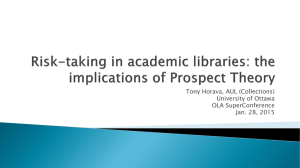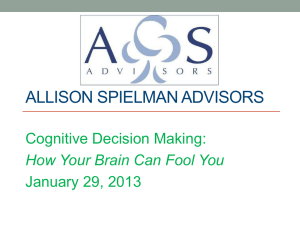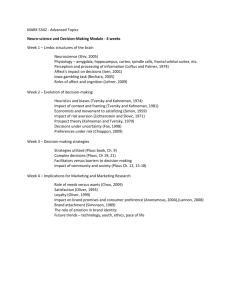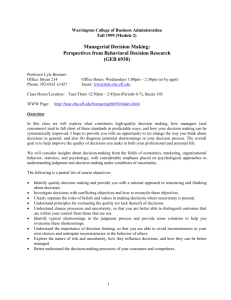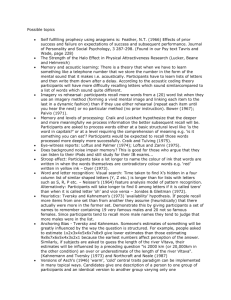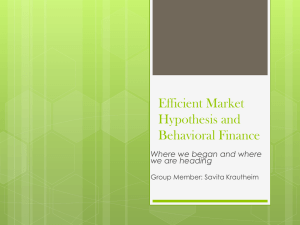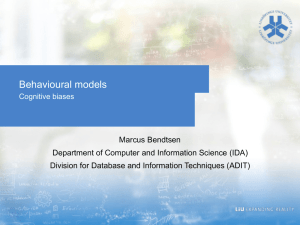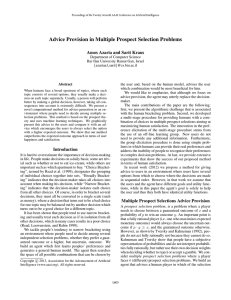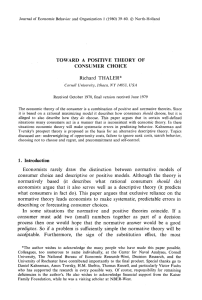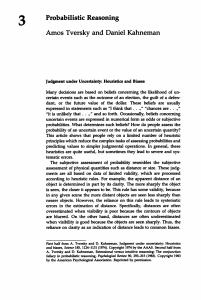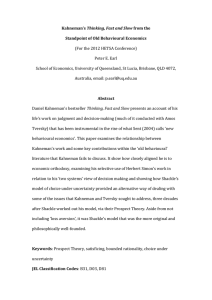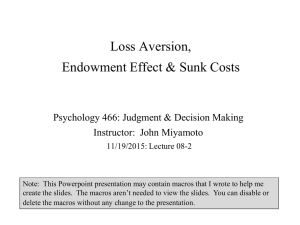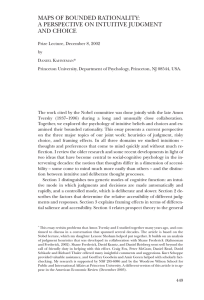Prospect Theory
advertisement
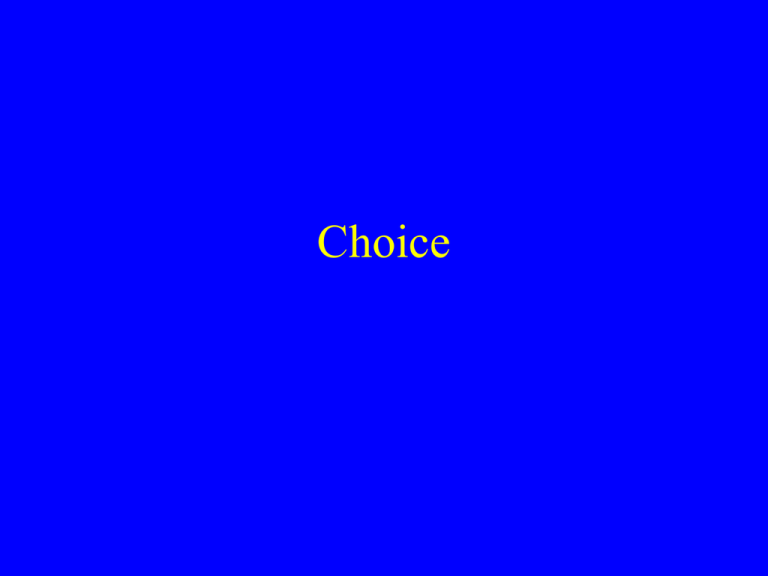
Choice There’s never just one reinforcer Hmm…what to do? Studying Choice Experimentally • Hernstein “concurrent schedules” VI 10 VI 30 The Matching Law • RA = rate of response A • rA = payoff rate for response A RA RA + RB rA = rA + r B responding Matching (R.J. Herrnstein) Choice with uncertainty in real life Kahneman & Tversky Kahneman’s Nobel Prize diploma 100 80 60 40 20 0 -20 -40 -60 -80 20 15 10 5 0 -5 -10 -15 -20 -25 -30 -35 -40 -100 v(x) [perceived value] Prospect Theory x [actual value] "We have an irrational tendency to be less willing to gamble with profits than with losses." Kahneman & Tversky (1981) Prospect Theory "We have an irrational tendency to be less willing to gamble with profits than with losses." Kahneman & Tversky (1981) Two programs to combat disease: • If program A is adopted, 200 people will be saved. • If program B is adopted, there is a 1/3 probability that 600 people will be saved, and 2/3 probability that no one will be saved. Two programs to combat disease: • If program C is adopted, 400 people will be die. • If program D is adopted, there is a 1/3 probability that nobody will die, and 2/3 probability that 600 people will die. Value Prospect Theory V(600) V(200) -600 loss -400 200 V(-400) V(-600) 600 gain A purchasing decision • A box of cereal costs $5 at the local grocery store, but only $2 at the grocery store across town. Would you go to the grocery store across town? A purchasing decision • A television costs $178 at the local electronics store, but only $175 at the electronics store across town. Would you go to the electronics store across town? loss --$2 v. -$5 -$178 v. -$175 Value Prospect Theory V(-2) v. V-5) V(-175) v. V(-178) gain You’re the CEO of a credit card company The customer must bear some of the costs associated with the processing of credit card purchases. How would you want the price difference to be framed? – A cash discount? – A credit card surcharge? Value Prospect Theory loss gain The loss side of the curve is steeper than the gain side. The pain of losses is stronger than the pleasure of gains. Endowment Effect Kahneman, Knetsch & Thaler (1990) Pilot studies showed the pen and mug to be equally preferred (50% of people prefer pen, 50% prefer mug) But when subjects actually given one item, and then given the opportunity to trade, only 10% traded Major features of prospect theory (summary) • Reference level dependence: An individual views consequences (monetary or other) in terms of changes from the reference level, which is usually that individual's status quo. • Gain and loss satiation: The values of the outcomes for both positive and negative consequences of the choice have the diminishing returns characteristic. • Loss aversion: The resulting value function is steeper for losses than for gains; losing $100 produces more pain than gaining $100 produces pleasure. The consequences of choice Having choices is a good thing, right? More choices = Better chance of finding what you want Ultimately more satisfaction with what you chose More freedom The consequences of choice More choices = More options to evaluate (more time and effort) More options to ultimately turn down More options to possibly regret turning down (opportunity costs) Consequences of choice Iyengar & Lepper (2000): Subjects choose one chocolate to sample Condition 1: Limited selection Condition 2: Extensive selection % who choose chocolate as compensation: 48% 12% Satisfaction with sampled chocolate (1-7 scale): 6.28 5.46 Deferral of Choice Redelmeier & Shafir (1995) Legislators in the Ontario Provincial Parliament presented with the following scenarios: Scenario #1: Scenario #2: There’s a failing hospital providing redundant services and losing money Two failing hospitals providing redundant services and losing money Do you close it down? Do you close one of them down? 66% say “yes” Only 25% say “yes”! Avoidance of Choice Tversky & Shafir (1992) Control Condition $1.50 v. Conflict Condition $1.50 v. ($2 value) v. ($2 value) ($2 value) 75% of S’s choose pen 47% of S’s choose a pen (53% choose money)! What to do? Be a satisficer. • Maximizers: – Seek and accept only the best – Strive to find the best possible decisions – Attempts to examine all alternatives before choosing – Often their decisions to the decisions of others – Feel less positive about their purchasing decisions – Savor positive events less – Do not cope as well with negative events – Tend to brood and ruminate more • Satisficers – Settle for good enough – Set criteria and standards; choose first option that meets them. Schwartz et al (2002) Are you a maximizer? From Schwartz et al (2002) 1. Whenever I’m faced with a choice, I try to imagine what all the other possibilities are, even ones that aren’t present at the moment 2. No matter how satisfied I am with my job, it’s only right for me to be on the lookout for better opportunities 3. I find that writing is very difficult, even if it’s just writing a letter to a friend, because it’s so hard to work things just right. I often do several drafts of even the simplest things. 4. I often fantasize about living in ways that are quite different from my actual life.
